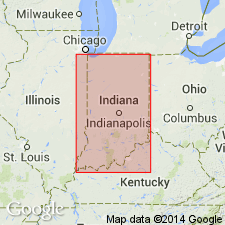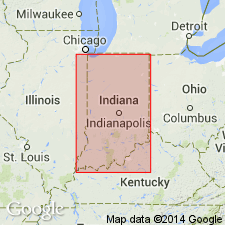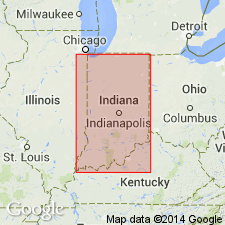
- Usage in publication:
-
- Spickert Knob facies
- Modifications:
-
- First used
- AAPG geologic province:
-
- Cincinnati arch
Summary:
Applied Spickert Knob facies to a lithologic development of his Locust Point formation in a part of southern IN. "This Spickert Knob facies is that of the type locality of the [Locust Point] formation at Locust Point."
Source: GNU records (USGS DDS-6; Reston GNULEX).

- Usage in publication:
-
- Spickert Knob Formation
- Modifications:
-
- Named
- Dominant lithology:
-
- Siltstone
- Shale
- Sandstone
- Limestone
- AAPG geologic province:
-
- Cincinnati arch
Summary:
The Locust Point and Carwood Formations of the Borden Group do not have a recognizable mutual boundary that consistently separates them outside their type areas, and they cannot be separately mapped. Together they represent parts of a depositional event that resulted in a single mappable unit, here named the Spickert Knob Formation of the Borden Group; the names Locust Point and Carwood are abandoned. The unit is described in Floyd Co, IN, where the name was used for a facies of the Locust Point Formation by Stockdale (1931). It consists of silty shale, siltstone, sandstone, and lenticular limestone. Gradationally overlies the Kenwood Member of the New Providence Shale; gradationally underlies the Floyds Knob Limestone Member of the Edwardsville Formation. Thickness at type section is 238 ft. Age is Early Mississippian (Keokuk), based on fossils.
Source: GNU records (USGS DDS-6; Reston GNULEX).

- Usage in publication:
-
- Spickert Knob Formation
- Modifications:
-
- Overview
- AAPG geologic province:
-
- Cincinnati arch
Summary:
Spickert Knob Formation is exact equivalent of Stockdale's Locust Point and Carwood Formations, which form a single depositional unit. In addition to the type section, three good reference sections are listed: 1) Type section of the former Locust Point Formation along a secondary road ascending the Knobstone Escarpment at the Ohio River in the NW1/4NE1/4 sec. 13, T4S, R5E, Harrison Co.; 2) a section east of Edwardsville along former IN 62 and the Southern RR and mainly in the NW1/4 sec. 6, T3S, R6E, and NE1/4 sec. 1, T3S, R5E; and 3) farther north, a section exposed along IN 135 near Millport in the NW1/4 sec. 29, T4N, R4E, Washington Co. Unit lies conformably between the New Providence Shale below and the Edwardsville Formation above. Represents delta-slope deposits, dominated by siltstone, but including abundant silty shale, some sandstone, and minor amounts of limestone. More shaly and argillaceous in the lower part and dominated by massive siltstone in the upper part. Contains ironstone nodules and geodes. Ranges between 225 and 300 ft in thickness. Approximately equivalent to the Nancy Member and the Holtsclaw Siltstone Member of the Borden Formation of north-central KY. Brachiopods, crinoids, and cephalopods contained within the Spickert Knob correspond to the time-stratigraphic limits of the Keokuk Limestone of the Mississippi Valley. Age is Early Mississippian (Valmeyeran).
Source: GNU records (USGS DDS-6; Reston GNULEX).
For more information, please contact Nancy Stamm, Geologic Names Committee Secretary.
Asterisk (*) indicates published by U.S. Geological Survey authors.
"No current usage" (†) implies that a name has been abandoned or has fallen into disuse. Former usage and, if known, replacement name given in parentheses ( ).
Slash (/) indicates name conflicts with nomenclatural guidelines (CSN, 1933; ACSN, 1961, 1970; NACSN, 1983, 2005, 2021). May be explained within brackets ([ ]).

